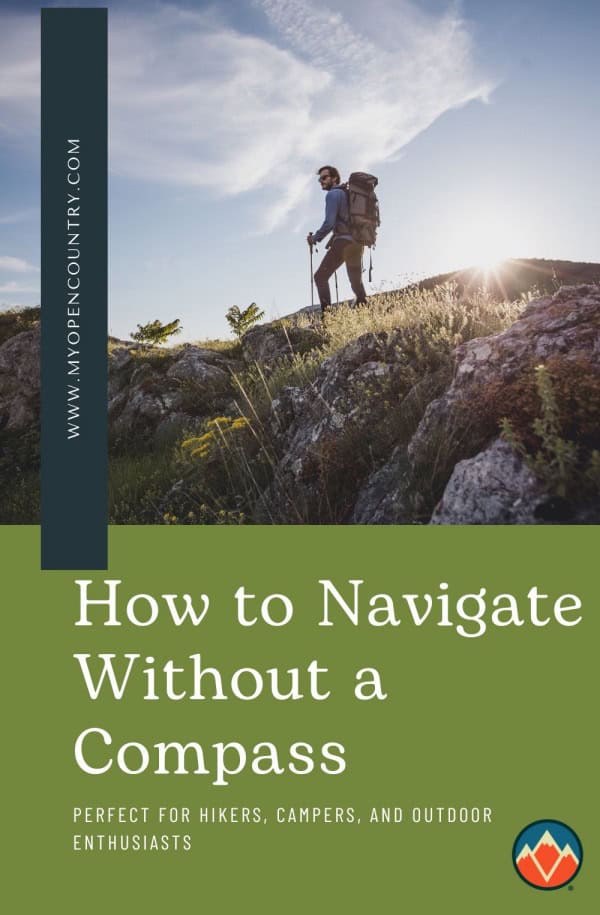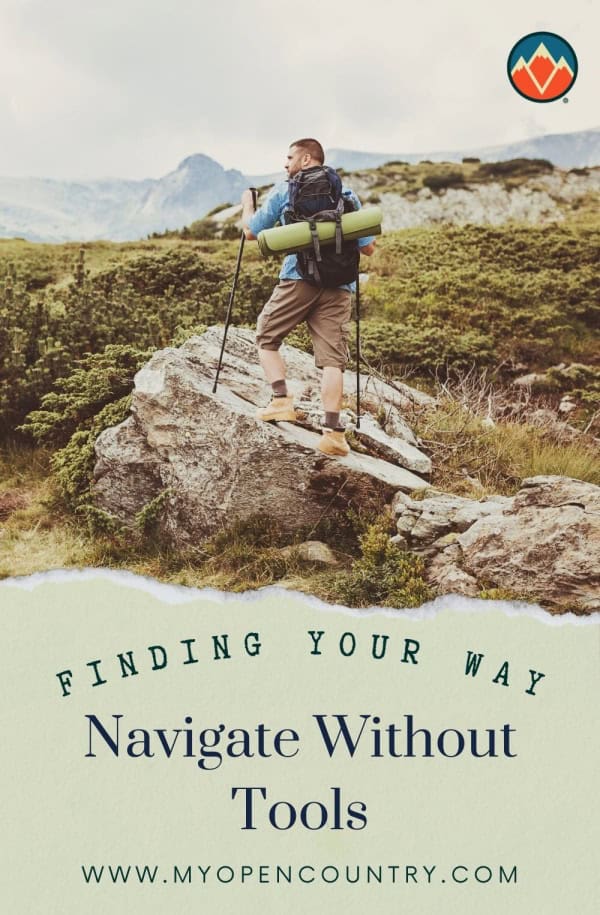You’re out on a long hike and a gust of wind takes your compass over a cliff.
The batteries on your hiking GPS tracker died around 3 months ago and you haven’t noticed until now.
The nearest cell phone signal that might have let you access online map apps is about 20 miles away, along with the nearest town.
What to do?
While for some it may seem that you’ve landed up that proverbial creek of crap without a paddle and prayer is your only recourse, there are a handful of ways you can get yourself out of bother.Below, we’ve made a list of the seven that will show you how to find yourself and get back home safely. Let’s learn how to navigate without a compass!
Table of Contents
Save for later!!! ⤵️

1. Use the Sun
The sun has more uses than being the mere source of all life on our planet. Given that the sun is a creature of habit and rises in the east and sets in the west, just by noting its position in the sky we can get a rough but workable idea of our bearings.
In the Northern Hemisphere, moreover, the sun’s highest point in any given day is directly south.
Naturally, the sun is higher in the sky in the summer than in winter, but if you can gauge the point at which it’s at its peak, you can easily calculate each of the four cardinal directions.
2. And the Stars…
When the sun turns in for the night, our natural daytime navigational resource is replaced by a nighttime version that’s every bit as useful: the stars.
When in the northern hemisphere the most obvious navigational aid in the night sky is a bright star called the North Star (Polaris), which, as the name suggests, gives us a pretty darn accurate bearing on north.
To find the North Star, the best thing to do is track down the Big Dipper—that big, bright, pan-with-bent-handle stellar formation.
Follow the line between the outermost two stars (on the right-hand side) of the Big Dipper up the way and eventually, your eyes will land on a big, resplendent star on its lonesome. That, formerly-lost-but-now-found navigator, is the North Star.
In the southern hemisphere, you need to make use of the Southern Cross, which is a collection of stars, which you may have guessed form a cross. If you draw an imaginary line from the top of the cross to the bottom and extending it 4.5 times, then this imaginary line points south. Now you can work out the other cardinal points
3. Use Your Topo
If your map didn’t take that aforementioned tumble with your compass, then you have a very reliable means of making your way to where you need to go, provided visibility is decent.
To navigate using your map alone, simply identify features in the terrain and locate them on your map (or vice-versa), and then use these to align the map with the terrain.
4. Use Water Features
Water features, in navigational parlance, are commonly known as ‘handrails’. This is because they can be used, like a railing that helps you walk up or down a flight of stairs, to guide you parallel to your desired course of travel.
If, for example, you know where a lake or river stands in relation to other features in the terrain, then you can follow the edge of either to where you need to go or use them as a reference when attempting to reach a nearby feature.
Small streams on mountainsides are maybe even more useful, particularly when hiking in low visibility and trying to descend.
Aqua, as we know, flows downhill and does so in order to join other water sources below. As such, if we happen to find a small stream on a mountainside, then we know that it will lead to another, lower-lying river or lake. If we have a rough idea of the main water features in the area, therefore, we’ll then have a reference that will help us establish our whereabouts.
Finally, there’s a reason that even the most insignificant puddles in mountainous terrain have names. In most cases, these puddles were historically used as reference points in the terrain that could aid navigation.
Before setting off, try to learn the name and shape of these features and where they stand in relation to others. By doing so, you’ll be providing yourself with a handy cache of waypoints that can help you find your way should you have any mishaps with your map.
5. Mental Mapping
Put in a little bit of pre-trip study time and get to know the lay of the land you’ll be heading into. By doing so, you’ll not only make it easier to navigate safely if you have compass problems but also be able to navigate more quickly by reducing the need to refer to your map and compass even when both are in good health.
With a mental picture of the area’s notable features, you can then tick off those features as you go to keep track of your whereabouts.
6. Sticks, Stones, and Shadows
If the sun’s out, one of the easiest ways to get a north bearing is achieved with a stick and a few stones.
Stand the (2 to 4-foot) stick in the ground. This should be a spot of clear, level ground mark where the tip of the shadow lands with your first stone, then wait for half an hour or so until the shadow has moved.
After that time, the end of the shadow will have moved to one side of the stick and also have gotten shorter or longer.
Place your second stone at the tip of this shadow, then draw a straight line in the dirt between the two stones. This line gives you your east-west axis, with the first stone marking west and the second marking east.
Now, if you stand at a perpendicular angle to the line you have traced, facing the opposite direction of the sun—keeping the first stone on your left—you will be facing north. Simple!
7. Use an Analog Watch
This isn’t the most accurate means of finding north due to the variance between standard time and solar time. However, it can at least help to give you a general bearing, provided you remember to make adjustments for daylight savings time by winding your watch back an hour if set to DST.
First, take your watch off and hold it out flat in the palm of your hand.
Point the hour hand to the sun, then draw a line between the halfway mark between the hour hand and 12 o’clock.
If, for example, it’s around 5 o’clock, then this line should fall between 2 and 3 on one side of the watch and 8 and 9 on the other side. This imaginary line across the face of your watch gives you your north-south line, with north represented by the side pointing away from the sun.
We hope you enjoyed our article, and hopefully, you can remember enough if you ever find yourself in the situation of walking around the woods in circles without any navigational aids. If you’ve had any wilderness frights, or know any other means of compass-free navigation, then please let us know in the comments below!
Save for later!!! ⤵️


